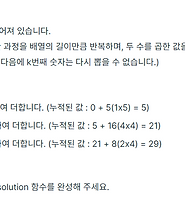짱이 될거야
백준 14888: 연산자 끼워넣기 Python (순열, DFS) 본문




https://www.acmicpc.net/problem/14888
14888번: 연산자 끼워넣기
첫째 줄에 수의 개수 N(2 ≤ N ≤ 11)가 주어진다. 둘째 줄에는 A1, A2, ..., AN이 주어진다. (1 ≤ Ai ≤ 100) 셋째 줄에는 합이 N-1인 4개의 정수가 주어지는데, 차례대로 덧셈(+)의 개수, 뺄셈(-)의 개수,
www.acmicpc.net
이 문제는 지문을 잘 읽어야 하는데, 우선 숫자의 순서는 변경하면 안된다.
문제를 보자마자 떠오른 방법은 순열이었는데 위 조건을 미처 보지 못해서 계속해서 헤맸다.
두 번째로 주의해야 할 것은 음수일 때 나눗셈을 하는 경우이다.
print(-6 // 2)를 했더니 -3으로 결과가 잘 나오길래 따로 조건을 달아주지 않았었는데, 그렇게 하면 예시3에서 최댓값이 틀리게 된다.
1. 순열 (라이브러리x)
N = int(input()) # N: 수의 개수
nums = list(map(int, input().split())) # nums: 수 배열
multi = list(map(int, input().split())) # multi: 연산자 (+, -, *, //)
# 연산자 리스트 만들기
operator = []
for i in range(4):
for j in range(multi[i]):
if i == 0:
operator.append('+')
elif i == 1:
operator.append('-')
elif i == 2:
operator.append('*')
else:
operator.append('//')
# 연산자 순열
def op_perm(n, k):
if n == k:
result = nums[0]
for m in range(n):
if operator[m] == '+':
result += nums[m + 1]
elif operator[m] == '-':
result -= nums[m + 1]
elif operator[m] == '*':
result *= nums[m + 1]
elif operator[m] == '//':
if result < 0:
result = (result * (-1) // nums[m+1]) * (-1)
else:
result //= nums[m + 1]
result_list.append(result)
else:
for l in range(k, n):
operator[l], operator[k] = operator[k], operator[l]
op_perm(n, k+1)
operator[l], operator[k] = operator[k], operator[l]
result_list = []
op_perm(len(operator), 0)
print(max(result_list))
print(min(result_list))코딩테스트를 치다보면 라이브러리를 사용하지 못하게 하는 경우도 있어서, 되도록이면 순열 또는 조합을 라이브러리 없이 구현하는 연습을 하려고 노력한다.
위 방법은 재귀를 이용한 방법인데, 이렇게 하면 Python3에서는 시간 초과가 나고 PyPy로 해야 겨우 통과한다.
하지만 메모리는 223236KB, 시간은 2144ms로 매우 효율이 떨어진다.
2. DFS
N = int(input()) # N: 수의 개수
nums = list(map(int, input().split())) # nums: 수 배열
operator = list(map(int, input().split())) # multi: 연산자 (+, -, *, //)
def dfs(n, k, total, plus, minus, multi, divide):
if n == k:
result_list.append(total)
return
else:
if plus:
dfs(n, k + 1, total + nums[k], plus-1, minus, multi, divide)
if minus:
dfs(n, k + 1, total - nums[k], plus, minus-1, multi, divide)
if multi:
dfs(n, k + 1, total * nums[k], plus, minus, multi-1, divide)
if divide:
if total < 0:
dfs(n, k + 1, (total * (-1) // nums[k]) * (-1), plus, minus, multi, divide - 1)
else:
dfs(n, k + 1, total // nums[k], plus, minus, multi, divide - 1)
result_list = []
dfs(N, 1, nums[0], operator[0], operator[1], operator[2], operator[3])
print(max(result_list))
print(min(result_list))아래 블로그를 참고해서 dfs로 풀었다.
Python3로도 패스를 했고 메모리는 30840KB, 시간은 88ms가 나왔다.
참고
'알고리즘' 카테고리의 다른 글
| 백준 1926: 그림 Python (BFS) (0) | 2022.10.12 |
|---|---|
| 백준 2644: 촌수계산 Python (DFS, BFS) (0) | 2022.10.12 |
| 프로그래머스: 최솟값 만들기 (0) | 2022.10.10 |
| 프로그래머스(스택/큐): 같은 숫자는 싫어 (0) | 2022.10.03 |
| 프로그래머스(완전탐색): 최소직사각형 (0) | 2022.10.02 |
Comments



